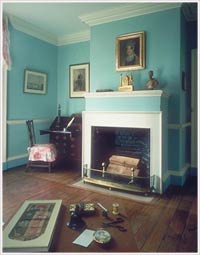Jefferson's Rumfords

|
Sir Benjamin Thompson, Count von Rumford Reprinted from http://www.monticello.org/site/research-and-collections/sir-benjamin-thompson-count-von-rumford#_ftnref5 (In case they don't keep it on line)
|
|
Sir Benjamin Thompson, Graf (Count) von Rumford (26 March 1753 - 21 August 1814)[1] was an American-born scientist and inventor. Thomas Jefferson was familiar with Rumford and his work, and some of his innovations were incorporated into the remodeling of Monticello. By 1796, when Rumford was first mentioned in Jefferson's papers, Rumford had already had a very eventful life. Born in Massachusetts in 1753, he departed for England in 1776 and served in the British army during the American Revolution. He was made a Fellow of the Royal Society and knighted by King George III before moving on to the Continent, where he found patronage with the elector of Bavaria, Karl Theodor. In 1790, he was granted the title of graf (count) of the Holy Roman Empire. The work for which Rumford is perhaps best known today is his energy-efficient design for fireplaces. His essay "Chimney Fireplaces, with Proposals for Improving them to Save Fuel; to Render Dwelling-houses more Comfortable and Salubrious, and Effectually to prevent Chimneys from Smoking" was first published in 1796, in the Bibliotheque Britannique in Geneva, and in volume I of his Essays, Political, Economical and Philosophical, published in London. An American edition of the Essays was published in 1798. A Rumford-design fireplace in the South Square Room. Thomas Jefferson owned volume I (Boston, 1798) and volume II (1799) of the three-volume American edition of Rumford's Essays.[2] However, it seems that Jefferson was familiar with Rumford's designs well before 1798. Jefferson's remodeling notes for Monticello, begun in November of 1796, contain sketches and notes for "Count Rumford's fire places in the square rooms;"[3] another "Design for Chimney and Flues", externally dated to 1797, also contains drawings and notes for a Rumford-style fireplace.[4] In 1799, he replied to his friend Wilson Cary Nicholas' request for the dimensions of Rumford fireplaces:
Only a single letter between Rumford and Jefferson is known to exist. In 1800, Rumford wrote on behalf of the Royal Institution of Great Britain to Jefferson, in his capacity as president of the American Philosophical Society, offering the APS a copy of the Royal Institution's recent publication, The Prospectus, Charter, Ordinances and Bye-Laws of the Royal Institution of Great Britain: Together with Lists of Proprietors and Subscribers. Rumford also conveyed to the APS the Royal Institution's desire "to cultivate a friendly Correspondence with them, and to cooperate with them in all things that may contribute to the Advancement of Science, and to the general Diffusion of the Knowledge of such new and useful Discoveries, and mechanical Improvements, as may tend to increase the Enjoyments, and promote the Industry, Happiness, and Prosperity of Mankind."[6] Jefferson never replied directly to this letter; he forwarded it, along with the enclosed publication, to Caspar Wistar, commenting that "the application of science to objects immediately useful in life, which seems to be the principal end of this establishment must interest in it's favor every friend of human happiness, & I have no doubt the society will meet with cordiality the overture made them, and add their example to the many existing proofs that the votaries of science, however widely dispersed, however separated by religion, by allegiance or vocation, form but one family."[7] Although they never met in person or corresponded to any degree, Jefferson certainly seemed to have an appreciation for Rumford's practical designs, and apparently had some degree of personal respect for him. In Jefferson's "Catalogue of Paintings &c. at Monticello" (c. 1809-1815), he listed a print of Count Rumford, in the lower tier of the Parlour, alongside prints of Thomas Paine and Tadeusz Kosciuszko.[8] Further Sources American National Biography, s.v. “Thompson, Benjamin.” Brown, Sanborn C. Benjamin Thompson, Count Rumford. Cambridge, Mass.: MIT Press, 1979. Buckley, Jim. "Reviving the Rumford." Journal of Light Construction Magazine, March 1994, 43-6. Dictionary of National Biography, s.v. “Thompson, Sir Benjamin.” Kaldenbach, Robert. "Lord of the Flues." Yankee Magazine, January 1998, 61-4. Larsen, Egon. An American in Europe: The Life of Benjamin Thompson, Count Rumford. New York: Philosophical Library, 1953. [1]This article is based on Anna Berkes, Monticello Research Report, November 2, 2010. [2] Sowerby 1182. This set is still extant at the Library of Congress. All three volumes of the London edition may be accessed online through the Hathi Trust Digital Library. [3] Jefferson, Monticello: remodeling notes, drawing N-147b, p. 16, Coolidge Collection of Thomas Jefferson Manuscripts, Massachusetts Historical Society. [4] Jefferson, “Design for Chimney and Flues,” [1797], in Papers of Thomas Jefferson 29:605. [5] Jefferson to Wilson Cary Nicholas, 2 May 1799, in Papers of Thomas Jefferson 31:102-3. [6] Rumford to Jefferson, London, 1 June 1800, in Papers of Thomas Jefferson 32:4. [7] Jefferson to Wistar, Washington, 16 December 1800, in Papers of Thomas Jefferson 32:311. [8] Jefferson, "Catalogue of Paintings &c. at Monticello," ca. 1809-1815, Thomas Jefferson Papers, Small Special Collections Library, University of Virginia.
|
Jefferson Rumford - comment
Sally Hemings Rumford
Poplular Forest Kitchen

Reader Comments
Buckley Rumford Fireplaces
Copyright 1995 - 2018 Jim Buckley
All rights reserved.
webmaster